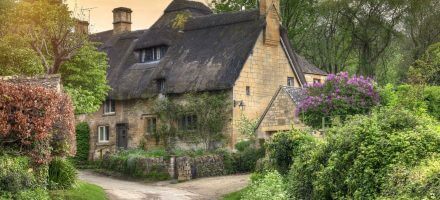The Route
Starting in the market town and former wool centre of Chipping Campden the Cotswold Way follows quiet paths and tracks through lush farmland and charming English villages, such as Broadway and Stanton. Meadows and the occasional woodland section are passed as the trail drops down to the ruins of Hailes Abbey before continuing to attractive former wool town of Winchcombe.
From there the route rises again and climbs up past the ancient long barrow of Belas Knap and, after passing through more woodland, to the highest point of the trail at Cleeve Hill (317m / 1040 ft). Through ancient beechwoods and limestone grassland and past some more prehistoric sites the route passes to the east and south of nearby Cheltenham and Gloucester.
Woodland sections and some more ascents and descents lead to a number of higher points with wide ranging vistas, including Cooper’s Hill, famous for its cheese rolling. The route then comes to the attractive town of Painswick before descending to cross the Stroudwater Canal.
A number of steep ups and downs reward with panoramic views and neolithic burial chambers and Iron Age hill forts accompany the trail through beech woods and fields on its way to the enchanting village of Wotton-under-Edge. From there the route gets more remote as it passes a number of picturesque beauty spots, interesting Cotswold houses and two more Iron Age forts.
The last section of the Cotswold Way passes the sprawling countryside estates of two wonderful old country homes at Dodington Park and Dyrham Park. After crossing a 17th century battlefield the route descends to Bath, one of the most beautiful cities in Britain, where the spectacular Bath Abbey and the Roman Baths are a fitting location to mark the end of the Cotswold Way.
Why walk the route from north to south?
The majority of hikers walk the Cotswold Way in a north to south direction, from Chipping Campden to Bath. As it can be a little difficult to get to or from Chipping Campden with public transport most walkers prefer to get this problem out of the way before they start their hike.
In addition, it is generally acknowledged that the north of the Cotswold Way passes a larger share of the attractive villages and towns typical of the Cotswolds. This means that the walk starts in the heartland of the Cotswolds, rather than in a city. Furthermore, ending a long walk in style in a city like Bath, with its long history, baths, Abbey and fine Georgian Architecture, provides a certain degree of triumph and achievement that seems only fitting.
Terrain Overview
The Cotswold Way tour is generally considered easy to moderate in difficulty. The route primarily follows well-kept footpaths, bridleways, traverse’s fields, ancient forests, and occasionally incorporates minor roads. Some sections can be muddy after periods of rain. It’s important to note that there are some challenging sections involving steep ascents and descents from the escarpment. The picturesque villages along the route are the perfect setting for leisurely pub lunches.
While the route doesn’t ascend to great heights, many walkers are surprised by the frequency of steeper climbs. There’s a bit of up and down on every section of the trail. The total aggregate ascent is approximately 4,000 meters over the entire route, with the highest point being just 317 meters above sea level.
Elevation Profile






























